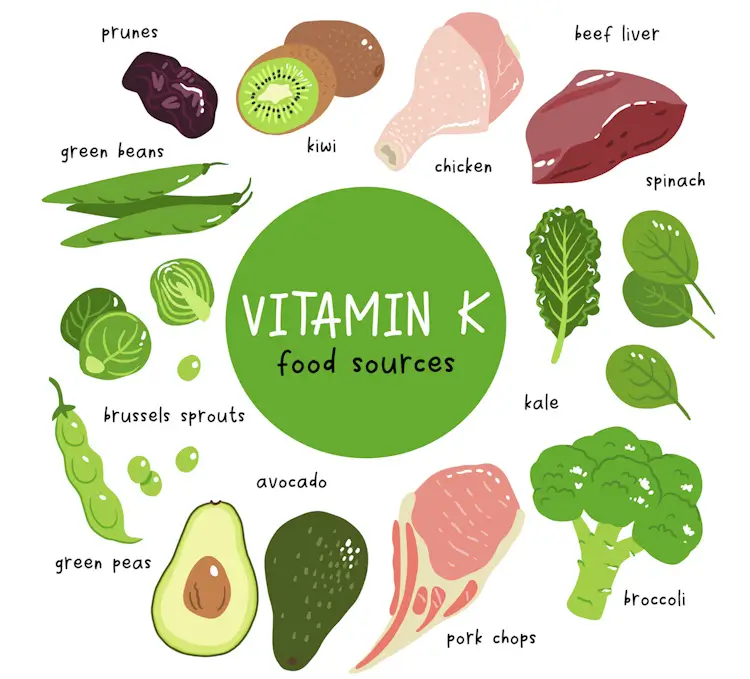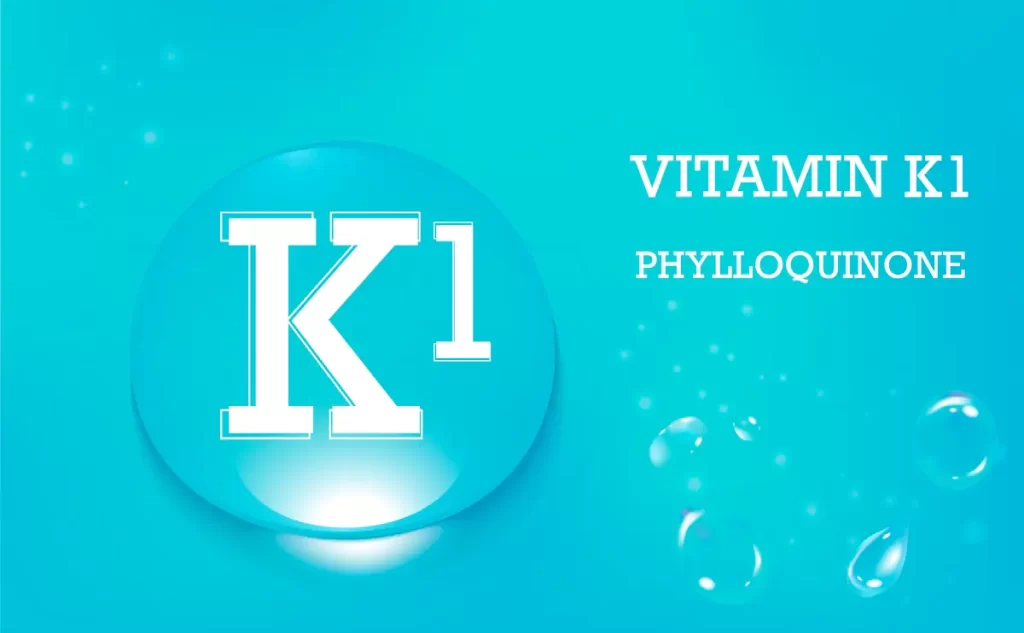Do you wonder why your body needs Vitamin K1? This fat-soluble vitamin helps your blood clot, stopping excessive bleeding when you’re hurt. It also supports strong bones and may protect your heart.
Thank you for reading this post, don't forget to subscribe!Keep reading to discover how Vitamin K1 works, its benefits, and where to find it in foods!
Key Takeaways
- Vitamin K1 supports blood clotting, strong bones, and protects arteries from calcium buildup. It activates proteins like osteocalcin for bone strength and Matrix Gla-protein (MGP) for heart health.
- High levels of Vitamin K1 lower osteoporosis risks. Studies show it improves bone mineral density and reduces fractures, especially in older adults.
- Leafy greens like kale, spinach, and collard greens are rich sources of Vitamin K1. Cooked kale offers about 1,062 mcg per cup. Vegetable oils like soybean oil also provide this nutrient.
- People taking blood thinners like warfarin need stable dietary intake since sudden changes can interfere with medication effectiveness.
- Deficiency leads to excessive bleeding or weak bones over time. Symptoms include easy bruising and slow-healing cuts; newborns face higher risks without supplements at birth.
The Essential Roles of Vitamin K1
Vitamin K1 helps your blood clot properly, which is vital for healing cuts and injuries. It also plays a key part in keeping bones strong and arteries healthy.
Blood Clotting Mechanisms
Blood clotting stops bleeding when you get injured. It relies on proteins called clotting factors, which work in a chain-like reaction known as the coagulation cascade. Vitamin K1 plays a key role here by helping your body activate seven of these proteins.
Without it, this process can’t function properly, leading to excessive bleeding or bruising. The γ-carboxylation of proteins—enabled by vitamin K—makes them biologically active and ready for use.
Vitamin K acts as a coenzyme during this process to support hemostasis, which prevents constant blood loss after injuries. This fat-soluble vitamin ensures that platelets form a plug at the damaged site while fibrin stabilizes it.
Factors like warfarin (Coumadin), a common blood thinner, can interfere with how vitamin K works in your body. Because of this interaction, people taking such medications may need carefully controlled levels of dietary vitamin K from leafy greens or supplements.
Bone Health Support
Vitamin K1 plays a big role in keeping bones strong. It activates proteins like osteocalcin and matrix Gla protein, which help bind calcium to the bone. Low levels of Vitamin K1 can lead to weaker bones and a higher chance of fractures, such as hip fractures.
Studies show that taking Vitamin K supplements improves bone density and lowers fracture risks.
Low serum Vitamin K1 is linked to poor bone mineral density (BMD). This condition increases the risk of osteoporosis over time. Eating leafy greens, like kale or spinach, gives your body this vital nutrient to support healthy bones.
Keeping enough Vitamin K in your diet protects against diseases tied to lower BMD while promoting better bone metabolism overall.
Arterial Health Maintenance
Arterial health relies on strong, flexible blood vessels. Vitamin K1 helps activate Matrix Gla-protein (MGP), which blocks calcium deposits in arteries. This action may prevent hardening of the arteries, a key factor in heart disease.
Studies suggest higher menaquinone intake links to lower coronary calcification and reduced mortality risk. Ensuring adequate levels of this fat-soluble vitamin supports overall heart health by keeping blood flow smooth and reducing artery damage over time.
Healthy arteries are vital for a strong heart.

Health Benefits of Adequate Vitamin K1 Intake
Vitamin K1 helps your body in many ways. It plays a big part in keeping your bones, heart, and overall health strong.
Prevention of Osteoporosis
Osteoporosis affects over 10 million adults in the U.S., with women making up 80% of cases. Higher vitamin K1 intake can help protect bones by improving bone mineral density and lowering the risk of hip fractures.
This fat-soluble vitamin works alongside calcium and vitamin D to strengthen bones.
Studies suggest that vitamin K may also boost muscle mass, helping combat conditions like sarcopenia. Green leafy vegetables such as spinach, kale, and collard greens are excellent sources of this nutrient.
Supplements might be helpful for those at higher risk or with medical conditions like celiac disease or short bowel syndrome.
Reduction in Coronary Heart Disease Risk
Vitamin K1 plays a role in heart health. Studies link adequate intake to lower coronary heart disease risks. It helps reduce arterial calcification, which can lead to blockages. Higher levels of menaquinones, or Vitamin K2, also show benefits for lowering heart disease deaths.
The Rotterdam Study (2004) found that people with more menaquinone intake had less coronary artery calcification and fewer heart problems. Foods like leafy greens and vegetable oils provide Vitamin K1, while fermented foods contain K2.
Both vitamins aid in maintaining healthier arteries over time.
Cognitive Health Improvements
Higher intake of Vitamin K1 supports better brain function. Studies show it connects to improved verbal episodic memory, like recalling details from a story or event. This is especially helpful as people age and experience cognitive decline.
Sufficient levels may protect against problems related to poor brain health. As a fat-soluble vitamin, it helps in reducing inflammation, which can damage the brain over time. Including green leafy vegetables like collard greens or spinach can help increase this nutrient in your diet effectively.
Recommended Daily Intakes of Vitamin K1
Your daily need for Vitamin K1 depends on your age and health. Read on to learn how much you might require!
Amounts for Different Age Groups
Getting the right amount of Vitamin K1 daily is crucial for supporting blood clotting, bone health, and overall well-being. Below is a simple breakdown of recommended daily intakes by age group:
| Age Group | Recommended Daily Intake (mcg) |
|---|---|
| Birth to 6 months | 2 mcg |
| 7 to 12 months | 2.5 mcg |
| 1 to 3 years | 30 mcg |
| 4 to 8 years | 55 mcg |
| 9 to 13 years | 60 mcg |
| 14 to 18 years | 75 mcg |
| Adult males (19+ years) | 120 mcg |
| Adult females (19+ years, including pregnancy and nursing) | 90 mcg |
This guide helps ensure healthy Vitamin K1 consumption for all age groups.
Adjustments for Specific Health Conditions
People with liver issues should avoid high vitamin K1 intake. This can lead to complications, as the liver processes fat-soluble vitamins like vitamin K. They may need special guidance from their doctor or nutritionist.
Those on blood-thinning medications must monitor their vitamin K1 closely. A sudden increase or decrease in dietary intake can affect the medicine’s effectiveness. Patients with celiac disease, ulcerative colitis, or cystic fibrosis might absorb less of this nutrient due to gut health problems.
Adding green leafy vegetables like collard greens and healthy fats such as olive oil can help improve absorption for these individuals.
Food Sources Rich in Vitamin K1
You can get Vitamin K1 from everyday foods like vegetables, oils, and fruits—making it easy to add to your meals. Read on for a deeper look at where to find these sources!
Leafy Green Vegetables
Cooked kale offers about 1,062 mcg of vitamin K1 per cup. Turnip greens provide around 530 mcg for the same amount. Collard greens deliver approximately 426 mcg per cooked cup, making them another great source.
Spinach, though slightly lower, still packs roughly 145 mcg when cooked.
These vegetables are nutrient-rich and low in calories. They also contain dietary fat-soluble vitamins essential for blood clotting and bone health. Adding leafy greens like these to meals boosts your intake effortlessly while supporting overall wellness.
Vegetable Oils
Soybean and canola oils are rich sources of vitamin K1. These oils supply a significant portion of this fat-soluble vitamin in the U.S. diet. A single tablespoon of soybean oil contains around 25 micrograms (mcg) of vitamin K1, supporting daily needs.
Olive oil and other vegetable oils also contribute to nutrient intake but in smaller amounts compared to soybean or canola oil. Using these oils for cooking or salad dressings makes it easy to incorporate more vitamin K into meals.

Certain Fruits and Dairy Products
Fruits and dairy products also provide vitamin K1, though in smaller amounts than vegetables. Kiwi contains 30 mcg of vitamin K1 per fruit. This equals 25% of the daily value (DV), making it a great snack option.
Cheese is another source, offering some vitamin K content. Though not as rich as green leafy vegetables, it can still add to your intake. Including fruits like kiwi or small servings of cheese helps diversify your sources of this fat-soluble nutrient.
Signs of Vitamin K1 Deficiency
A lack of Vitamin K1 can lead to unusual bleeding or easy bruising. It may also affect bone strength, making fractures more likely over time.
Symptoms and Health Implications
Excessive bleeding is the main symptom of vitamin K deficiency. Cuts may take longer to stop bleeding, and bruises may appear easily. Dark, tar-like stools with blood can signal internal bleeding.
Infants face higher risks due to low vitamin K transfer from mothers during pregnancy and breastfeeding. Severe cases in newborns can lead to brain bleeds or umbilical cord site bleeding.
Conditions like celiac disease or cystic fibrosis, which affect fat absorption, raise this risk for all ages.
Potential Health Risks from Excessive Vitamin K1
Too much Vitamin K1 can interfere with certain medications and may cause health issues—learn the risks to stay informed.
Interaction with Medications
Warfarin, a common blood thinner, interacts directly with vitamin K1. It reduces clotting factors that depend on the vitamin. People taking Warfarin need a stable intake of foods rich in Vitamin K1 like collard greens or canola oil.
Sudden changes in diet can affect how this medication works and raise health risks.
Certain drugs also lower vitamin K absorption. Antibiotics disrupt gut bacteria that help produce the nutrient. Bile acid sequestrants and weight-loss drugs like Orlistat interfere by blocking fat absorption, which is needed for this fat-soluble vitamin.
If you use these medications, talk to your doctor about dietary adjustments or supplements to prevent problems like bleeding disorders or low bone mineral density.
Conditions of Over-supplementation
Taking too much Vitamin K1 through supplements can cause problems. It might reduce the effect of blood thinners like warfarin, which increases the risk of dangerous blood clots. Consuming more than your tolerable upper intake level (UL) could also lead to health concerns, such as gastrointestinal upset or an imbalance with other fat-soluble vitamins.
Over-supplementation does not typically happen from food sources like leafy green vegetables or vegetable oils but rather from high-dose dietary supplements. People on medications for chronic conditions should consult their doctor before taking vitamin K supplements to avoid possible side effects.

FAQs on Vitamin K1
Get answers to common questions about Vitamin K1, its benefits, and how to include it in your diet!
Differences Between Vitamin K1 and K2
Vitamin K1 and K2 differ in their roles and sources. Vitamin K1, found mostly in green leafy vegetables like collard greens and spinach, supports blood clotting. It works to prevent excessive bleeding by helping your body form clots when needed.
Its half-life is about 8 hours, meaning it doesn’t stay long in the body.
Vitamin K2 handles calcium regulation and bone health. It appears more often in fermented foods, animal products, or fermented soybeans like natto. Subtypes of K2 (menaquinones) last several days in the body.
These subtypes also help reduce coronary artery calcification risks—linked to heart health problems like coronary heart disease.
…
How to Safely Integrate Vitamin K1 into Your Diet
Talk to your doctor before increasing vitamin K1 intake, especially if you take blood thinners. Some medications, like warfarin, can interact with this nutrient and cause complications.
People with certain conditions—like celiac disease or cystic fibrosis—may need extra help managing their diet.
Eat foods rich in green leafy vegetables such as spinach and collard greens. Pair these foods with small amounts of fat for better absorption since vitamin K1 is fat-soluble. Olive oil or roasted soybeans make good choices for healthy fats.
Aim to include other sources too, like dairy products or vegetable oils such as canola oil, in a balanced meal plan that meets your dietary needs.
The Importance of Vitamin K in Bone Health
Vitamin K plays a vital role in bone metabolism. It activates osteocalcin, a protein needed to bind calcium to bones. This process strengthens bones and boosts their density. Higher levels of vitamin K are linked to increased bone mineral density and fewer fractures—especially hip fractures in older adults.
A lack of vitamin K can weaken bones over time. Older people with low bone mineral density or osteoporosis face higher risks without enough vitamin K intake. Leafy green vegetables like spinach and kale are great sources, along with oils such as soybean oil and olive oil.
Conclusion
Understanding Vitamin K1 helps you make smarter choices for your health. It supports blood clotting, strengthens bones, and may lower heart disease risks. Adding leafy greens and other rich sources to your meals is an easy step toward better well-being.
Pay attention to your diet and daily needs—your body will thank you!
For a comprehensive understanding of how vitamin K2 complements the benefits and functions of K1, especially in bone health, explore our detailed guide on Vitamin K2.
